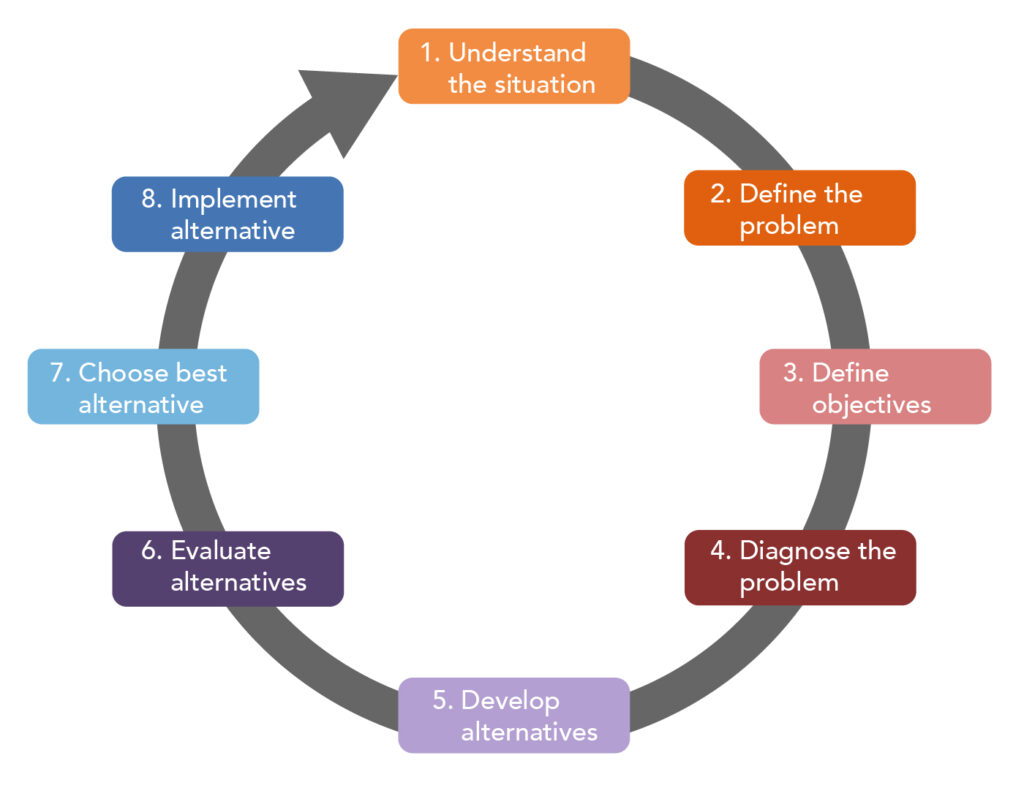
Imagine a world where every decision-making process is smooth, harmonious, and conflict-free. A world where individuals come together, share their opinions, and work towards a common goal without friction. In this article, we will explore practical strategies and techniques to help you make decisions collectively without clashing. Whether it’s deciding on a family vacation destination, choosing a project at work, or resolving conflicts within a team, we will provide you with valuable tips to ensure that everyone’s voice is heard and respected. So, let’s embark on this journey of collaborative decision-making and discover ways to navigate the path towards consensus.

This image is property of cdnwp.tonyrobbins.com.
Creating an Effective Decision-Making Process
Setting Clear Objectives
In order to make effective decisions, it is essential to start by setting clear objectives. Clearly defining the desired outcome or goal will help guide the decision-making process and ensure that everyone involved knows what they are working towards. These objectives should be specific, measurable, attainable, relevant, and time-bound (SMART). By setting clear objectives, you provide a roadmap for the decision-making process and increase the chances of reaching a successful outcome.
Establishing a Structured Framework
One of the keys to effective decision-making is to establish a structured framework that outlines the steps and processes to be followed. This framework should provide a clear and organized structure for discussing, evaluating, and making decisions. For example, you might establish a process that includes gathering relevant information, evaluating options, discussing pros and cons, and ultimately making a decision based on the agreed-upon criteria. By having a structured framework in place, you can ensure that decisions are made in a logical and systematic manner.
Encouraging Open Communication
Open communication is crucial for successful decision-making. By creating an environment where all participants feel comfortable expressing their thoughts, ideas, and concerns, you allow for a more comprehensive exploration of the decision at hand. Encouraging open communication means actively listening to others, encouraging diverse perspectives, and creating a safe space where everyone can contribute without fear of judgment or retribution. By fostering an atmosphere of openness and inclusivity, you enhance the quality of the decision-making process and increase the chances of a positive outcome.
Promoting Active Listening
Active listening is a critical skill in decision-making. It involves giving your full attention to the speaker, seeking to understand their perspective, and asking clarifying questions to ensure comprehension. By actively listening to others, you demonstrate respect and validate their contributions. This not only helps to build rapport and trust but also enables you to gather valuable insights and perspectives that can inform the decision-making process. By actively listening, you create an environment in which everyone feels heard and valued, leading to more thoughtful and informed decision-making.
Fostering Collaboration and Consensus Building
Collaboration and consensus building are essential aspects of effective decision-making. By involving multiple stakeholders and encouraging their active participation, you can leverage diverse perspectives and insights. Collaboration allows for a wider range of ideas and suggestions, which can lead to innovative solutions and improved decision outcomes. Consensus building, on the other hand, involves seeking agreement among the participants, finding common ground, and reaching a decision that everyone can support. By fostering collaboration and consensus building, you create a sense of ownership and commitment among the decision-makers, increasing the likelihood of successful implementation.
Managing Conflict and Differences of Opinion
Identifying and Addressing Conflict
Conflict is a natural part of the decision-making process, as different individuals may have differing opinions, goals, or interests. It is essential to identify and address conflicts early on to prevent them from escalating and negatively impacting the decision-making process. By openly acknowledging and discussing conflicts, you can work towards finding mutually agreeable solutions or compromises that can satisfy all parties involved. Ignoring or avoiding conflicts can hinder progress and lead to unresolved issues that undermine the effectiveness of the decision-making process.
Utilizing Conflict Resolution Techniques
When conflicts arise, it is important to have conflict resolution techniques in place to address the issues constructively. These techniques can include active listening, seeking common ground, exploring alternative perspectives, and finding win-win solutions. By utilizing these techniques, you encourage open dialogue, empathy, and understanding, which can help to de-escalate conflicts and foster a more cooperative decision-making environment. Conflict resolution techniques provide a structured approach to managing conflicts and can lead to more productive and harmonious decision-making outcomes.
Finding Win-Win Solutions
In decision-making, it is often beneficial to seek win-win solutions that address the needs and interests of all parties involved. A win-win solution is one in which all stakeholders feel that their concerns have been heard and considered, and the decision reached benefits everyone to some degree. By focusing on collaborative problem-solving and exploring creative alternatives, you can often find win-win solutions that satisfy multiple perspectives. This approach promotes cooperation, encourages trust, and avoids the pitfalls of a zero-sum mentality where one party’s gain is perceived as another party’s loss.
Embracing Diversity of Perspectives
Diversity of perspectives is a valuable asset in decision-making. By embracing different viewpoints, experiences, and backgrounds, you can tap into a wealth of knowledge and insights. Encouraging diverse perspectives can lead to a more comprehensive understanding of the problem at hand and foster innovative thinking. When individuals with different perspectives collaborate, they challenge assumptions, identify blind spots, and broaden the scope of possibilities. By actively seeking and valuing diverse perspectives, you create a more inclusive decision-making process that benefits from the collective wisdom of the group.
Ensuring Equal Participation and Fairness
Including All Stakeholders
To ensure equal participation and fairness in the decision-making process, it is crucial to include all relevant stakeholders. Stakeholders are individuals or groups who are directly or indirectly affected by the decision and have a vested interest in its outcome. By involving all stakeholders, you ensure that their voices are heard, their concerns are taken into account, and their perspectives are considered. Inclusion promotes fairness and prevents the marginalization of certain groups or individuals, ultimately leading to better-informed decisions and increased buy-in from those affected by the decision.
Promoting Equity and Inclusivity
Promoting equity and inclusivity in decision-making involves recognizing and addressing power dynamics and ensuring that everyone has an equal opportunity to contribute. This includes actively seeking out and valuing diverse perspectives, creating an environment of psychological safety, and providing avenues for underrepresented voices to be heard. By promoting equity and inclusivity, you create a more balanced and democratic decision-making process that is considerate of the needs and interests of all individuals involved.
Implementing Rotating Leadership Roles
Rotating leadership roles in the decision-making process can help prevent power imbalances and promote equal participation. By allowing different individuals to take on leadership roles, you distribute decision-making authority and ensure that no single individual or group dominates the process. Rotating leadership roles also provide individuals with opportunities to develop leadership skills, gain confidence, and contribute their unique perspectives. This approach promotes fairness and prevents the concentration of power in decision-making, leading to more inclusive and balanced outcomes.
Avoiding Power Imbalances
Power imbalances can undermine the effectiveness and fairness of the decision-making process. It is important to be aware of power dynamics and take steps to avoid or mitigate any imbalances that may arise. This can be achieved by creating a culture of respect and equality, where everyone’s voice is valued and no one’s opinions are dismissed or favored based on their position or influence. Avoiding power imbalances requires being vigilant against favoritism, cliques, or exclusionary practices that can undermine the legitimacy and fairness of the decision-making process.
Establishing Effective Decision-Making Structures
Defining Roles and Responsibilities
Clearly defining roles and responsibilities is essential for effective decision-making. By assigning specific tasks and roles to individuals, you ensure that everyone knows what is expected of them and can contribute effectively to the decision-making process. This clarity helps to streamline decision-making, prevent duplication of efforts, and promote accountability. Defining roles and responsibilities also helps to balance the workload and prevent individuals from feeling overwhelmed or excluded.
Creating Decision-Making Teams
Decision-making teams can play a crucial role in ensuring effective decision-making. By assembling a diverse group of individuals with complementary skills and knowledge, you can benefit from a wider range of perspectives and expertise. Decision-making teams can help distribute the workload, foster collaboration, and promote a sense of collective ownership over the decisions made. When creating decision-making teams, it is important to consider diversity, ensuring that all relevant stakeholders are represented and that there is a balance of skills, experiences, and perspectives.
Implementing Decision-Making Tools and Techniques
Decision-making tools and techniques can provide structure and guidance in the decision-making process. These tools can range from simple frameworks, such as SWOT analysis or decision matrices, to more complex models, such as cost-benefit analysis or consensus-based approaches. Implementing decision-making tools and techniques can help to ensure that decisions are made systematically and based on relevant data and criteria. These tools can also facilitate the evaluation of options, comparison of alternatives, and documentation of the decision-making process.
Delegating Authority Appropriately
Delegating authority appropriately is crucial for efficient decision-making. It involves entrusting individuals or teams with the responsibility and power to make decisions within their area of expertise or jurisdiction. By delegating authority, you empower individuals to take ownership of decisions and ensure that decisions are made at the appropriate level of the organization. Delegating authority also promotes efficiency by preventing bottlenecks and enabling decisions to be made in a timely manner. However, it is important to establish clear guidelines and mechanisms for accountability to ensure that delegated authority is exercised responsibly.

This image is property of www.sessionlab.com.
Considering Relevant Information and Expertise
Gathering Sufficient Data
In order to make well-informed decisions, it is essential to gather sufficient data and information. This includes collecting relevant facts, figures, and other evidence that can inform the decision-making process. Gathering data can involve conducting research, analyzing existing information, or seeking input from subject matter experts. By ensuring that decisions are based on reliable and up-to-date information, you reduce the risk of making ill-informed or biased decisions and increase the chances of achieving desired outcomes.
Seeking Multiple Perspectives
Seeking multiple perspectives is crucial for comprehensive decision-making. By actively seeking out diverse viewpoints and soliciting input from a range of stakeholders, you can gain a more comprehensive understanding of the issue at hand. This can help to identify potential blind spots, challenge assumptions, and uncover innovative solutions. Seeking multiple perspectives allows for a more balanced and informed decision-making process and increases the likelihood of reaching a successful outcome.
Expert Input and Advice
Seeking expert input and advice is an important aspect of effective decision-making. Experts are individuals who possess specialized knowledge, skills, or experience relevant to the decision at hand. By consulting experts, you can tap into their expertise, gain insights, and benefit from their informed opinions and advice. Expert input can help to validate assumptions, provide alternative perspectives, and improve the overall quality of decision-making. It is important, however, to critically evaluate expert advice and consider it in conjunction with other relevant information and perspectives.
Valuing All Types of Knowledge
In decision-making, it is important to value all types of knowledge, including both formal and informal knowledge. Formal knowledge refers to knowledge that is codified, structured, and backed by evidence or research. This can include scientific studies, industry reports, or best practices. Informal knowledge, on the other hand, is based on personal experiences, tacit knowledge, and individual expertise. By valuing both forms of knowledge, you can benefit from a more comprehensive understanding of the decision at hand. This requires creating an environment that encourages the sharing and integration of knowledge from diverse sources.
Creating a Positive and Supportive Environment
Promoting Trust and Psychological Safety
Creating a positive and supportive environment is crucial for effective decision-making. This starts with promoting trust among individuals and fostering a sense of psychological safety. Trust is built on open and honest communication, reliability, and mutual respect. Psychological safety, on the other hand, refers to a climate where individuals feel safe to take interpersonal risks, such as expressing their opinions or challenging the status quo, without fear of negative consequences. By promoting trust and psychological safety, you create an environment where individuals feel comfortable contributing their perspectives, ideas, and concerns, leading to better decision outcomes.
Encouraging Constructive Feedback
Constructive feedback plays a vital role in improving decision-making. By providing and encouraging constructive feedback, you create opportunities for individuals to learn and grow. Constructive feedback focuses on the behavior or actions rather than the person, is specific and actionable, and aims to support individual development rather than criticize. By fostering a culture of constructive feedback, you promote a continuous learning mindset and encourage individuals to reflect on their decision-making process, identify areas for improvement, and make adjustments as needed.
Recognizing and Valuing Contributions
Recognizing and valuing contributions is important for creating a positive and inclusive decision-making environment. Acknowledging and appreciating individuals’ contributions and efforts helps to build morale, motivation, and a sense of belonging. By recognizing the value that each individual brings to the decision-making process, you foster a culture of appreciation and respect. This, in turn, encourages continued engagement and participation, promoting a more collaborative and effective decision-making process.
Encouraging Learning and Growth
A commitment to learning and growth is essential for effective decision-making. By encouraging individuals to learn from their experiences, take risks, and embrace failure as a learning opportunity, you create a culture of continuous improvement. Encouraging learning and growth involves providing resources and support for professional development, creating space for reflection and self-assessment, and fostering a growth mindset that embraces challenges and seeks personal and collective growth. By promoting a culture of learning and growth, you empower individuals to take ownership of their decision-making skills and contribute to the overall effectiveness of the decision-making process.

This image is property of s3-us-west-2.amazonaws.com.
Building Effective Communication Strategies
Establishing Clear Channels of Communication
Establishing clear channels of communication is vital for effective decision-making. By defining how information is shared, who needs to be included in the communication process, and how feedback is gathered, you ensure that communication flows smoothly and efficiently. Clear communication channels can include regular team meetings, email updates, project management tools, or any other means that facilitate timely and transparent communication. By establishing clear channels of communication, you reduce the risk of miscommunication, ensure that all relevant information is shared, and enable stakeholders to stay informed throughout the decision-making process.
Practicing Active and Constructive Communication
Active and constructive communication is key to successful decision-making. This involves actively listening to others, speaking clearly and respectfully, and seeking to understand before being understood. Active and constructive communication also includes asking clarifying questions, validating others’ perspectives, and avoiding defensive or confrontational behaviors. By practicing active and constructive communication, you foster a collaborative and inclusive decision-making environment where everyone feels valued and heard.
Avoiding Assumptions and Stereotypes
Assumptions and stereotypes can hinder effective decision-making by biasing perceptions and limiting the consideration of alternative viewpoints. It is important to be mindful of the assumptions we make about others and the potential biases that may influence our decision-making. By actively questioning assumptions and challenging stereotypes, we can overcome biases and foster a more inclusive and unbiased decision-making process. This requires cultivating an environment where individuals feel safe to express their thoughts and ideas and where assumptions and stereotypes are openly challenged and discussed.
Using Nonviolent Communication
Nonviolent communication is a communication approach that focuses on empathy, mutual understanding, and the resolution of conflicts. It emphasizes compassionate listening, expressing oneself without judgment or criticism, and seeking to understand others’ needs and feelings. By using nonviolent communication techniques, such as active listening, expressing feelings without blame, and making requests rather than demands, you create an environment of respect and understanding. Nonviolent communication can help to prevent misunderstandings, promote collaboration, and build strong relationships that enhance the effectiveness of the decision-making process.
Balancing Individual and Collective Decision-Making
Understanding Individual Needs and Preferences
Balancing individual needs and preferences is important for inclusive decision-making. Each individual brings their own unique perspectives, experiences, and preferences to the decision-making process. By understanding and considering these individual differences, you can ensure that decisions take into account the diverse needs and aspirations of the group. Understanding individual needs and preferences requires active listening, empathy, and a willingness to accommodate differing viewpoints. By finding a balance between individual and collective interests, you promote a more inclusive and fair decision-making process.
Encouraging Shared Responsibility
Encouraging shared responsibility is essential for effective decision-making. By distributing decision-making authority and accountability among the group, you foster a sense of collective ownership and engagement. Shared responsibility promotes collaboration, trust, and a commitment to the collective good. It also helps to prevent the concentration of power and allows for a more democratic decision-making process. By encouraging shared responsibility, you foster a culture of active participation and accountability, leading to more inclusive and successful decision outcomes.
Seeking Consensus while Respecting Differences
Seeking consensus while respecting differences is an effective approach to decision-making. Consensus involves seeking agreement among the group and finding a solution that is acceptable to all members, even if it may not be the preferred outcome for each individual. It requires active listening, open dialogue, and a willingness to explore and understand different perspectives. Respecting differences means valuing diverse viewpoints and understanding that reaching consensus may require compromise. By seeking consensus while respecting differences, you promote a collaborative and inclusive decision-making process that enhances the chances of successful implementation.
Implementing Voting or Majority Rule when Consensus Cannot Be Reached
In some situations, reaching consensus may not be possible, especially when there are strongly conflicting viewpoints or time constraints. In such cases, it may be necessary to implement a voting or majority rule approach to make a decision. Voting allows for a democratic decision-making process where each individual has an equal say, and the outcome is determined by a majority vote. While voting or majority rule may not always satisfy everyone’s preferences, it provides a mechanism for making decisions when consensus cannot be achieved. It is important to ensure that the voting process is fair, transparent, and well-documented to maintain the integrity of the decision-making process.

This image is property of media.gq.com.
Fostering a Culture of Collaboration and Cooperation
Encouraging a Collective Mindset
Encouraging a collective mindset is essential for fostering collaboration and cooperation in decision-making. A collective mindset emphasizes the shared values, goals, and interests of the group, rather than individual agendas or personal gain. By fostering a collective mindset, you promote a sense of unity, common purpose, and a commitment to working together towards a shared vision. This mindset helps to overcome individual biases, promote collaboration, and foster a positive decision-making environment that is conducive to effective teamwork and cooperation.
Promoting Teamwork and Collaboration
Promoting teamwork and collaboration is crucial for successful decision-making. By encouraging individuals to work together, share ideas, and leverage each other’s strengths, you can tap into the collective intelligence of the group. Collaboration promotes synergy, creativity, and effective problem-solving. It also fosters a sense of mutual support and accountability, leading to better decision outcomes and a more satisfying and fulfilling decision-making process.
Building Relationships and Trust
Building relationships and trust is fundamental to effective decision-making. Trust is the foundation of any successful collaboration and requires open and honest communication, reliability, and a commitment to shared goals. Building relationships involves investing time and effort in getting to know and understand others, fostering a sense of connection and mutual respect. By building relationships and trust, you create a supportive and cohesive decision-making environment where individuals feel safe to share their thoughts and ideas and work together towards common objectives.
Recognizing and Celebrating Achievements
Recognizing and celebrating achievements is important for fostering a culture of collaboration and cooperation. By acknowledging and appreciating the contributions of individuals and the collective, you reinforce positive behaviors and create a sense of collective pride and accomplishment. Celebrating achievements can take various forms, such as public recognition, rewards and incentives, or simply expressing gratitude and appreciation. By recognizing and celebrating achievements, you cultivate a positive and supportive decision-making environment that encourages continued engagement and fosters a sense of collective achievement.
Seeking Mediation or Third-Party Facilitation
Engaging Neutral Mediators or Facilitators
In situations where conflicts or disagreements persist, or when the decision-making process becomes stuck, seeking the help of neutral mediators or facilitators can be beneficial. Mediators or facilitators are individuals who are trained in conflict resolution techniques and can help to facilitate a productive and respectful dialogue among the decision-makers. By engaging neutral mediators or facilitators, you introduce a fresh perspective and create an opportunity for all parties to be heard and understood. This can lead to the resolution of conflicts, the building of bridges, and the reestablishment of a positive decision-making environment.
Creating a Safe Space for Dialogue
Creating a safe space for dialogue is crucial when seeking mediation or third-party facilitation. A safe space is an environment where individuals feel comfortable expressing their thoughts and emotions, without fear of judgment or negative consequences. Creating a safe space involves setting ground rules for respectful communication, actively listening to others without interrupting or criticizing, and encouraging empathy and understanding. By creating a safe space, you promote open and honest dialogue, facilitate the resolution of conflicts, and restore trust in the decision-making process.
Ensuring Impartiality and Objectivity
Impartiality and objectivity are key qualities of effective mediators or facilitators. Impartiality ensures that the mediator or facilitator does not favor any particular individual or group, but instead remains neutral and unbiased throughout the process. Objectivity involves basing decisions and recommendations on facts and evidence, rather than personal opinions or emotions. By ensuring impartiality and objectivity, you create a fair and transparent decision-making process that is trusted by all parties involved.
Supporting Mediation and Facilitation Processes
Supporting the mediation and facilitation processes is crucial for their success. This includes providing the necessary resources, time, and support to ensure that the processes are effective and can deliver meaningful results. Supporting mediation and facilitation processes involves communicating the importance of these processes, providing training and guidance on conflict resolution techniques, and addressing any concerns or challenges that arise. By supporting mediation and facilitation processes, you demonstrate a commitment to fair and inclusive decision-making and enhance the chances of resolving conflicts and reaching mutually agreeable solutions.
In conclusion, creating an effective decision-making process requires a combination of clear objectives, structured frameworks, open communication, active listening, collaboration, and consensus building. Managing conflicts and differences of opinion involves identifying and addressing conflicts, utilizing conflict resolution techniques, finding win-win solutions, and embracing diversity of perspectives. Ensuring equal participation and fairness requires including all stakeholders, promoting equity and inclusivity, implementing rotating leadership roles, and avoiding power imbalances. Establishing effective decision-making structures involves defining roles and responsibilities, creating decision-making teams, implementing decision-making tools and techniques, and delegating authority appropriately. Considering relevant information and expertise involves gathering sufficient data, seeking multiple perspectives, seeking expert input and advice, and valuing all types of knowledge. Creating a positive and supportive environment entails promoting trust and psychological safety, encouraging constructive feedback, recognizing and valuing contributions, and encouraging learning and growth. Building effective communication strategies involves establishing clear channels of communication, practicing active and constructive communication, avoiding assumptions and stereotypes, and using nonviolent communication. Balancing individual and collective decision-making requires understanding individual needs and preferences, encouraging shared responsibility, seeking consensus while respecting differences, and implementing voting or majority rule when consensus cannot be reached. Fostering a culture of collaboration and cooperation involves encouraging a collective mindset, promoting teamwork, building relationships and trust, and recognizing and celebrating achievements. Seeking mediation or third-party facilitation can be beneficial in managing conflicts and restoring a positive decision-making environment. Engaging neutral mediators or facilitators, creating a safe space for dialogue, ensuring impartiality and objectivity, and supporting mediation and facilitation processes are crucial components of utilizing these methods effectively. By following these guidelines and implementing these strategies, you can create an effective decision-making process that maximizes individual and collective contributions, fosters cooperation and collaboration, and leads to successful outcomes.






